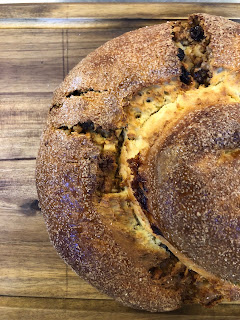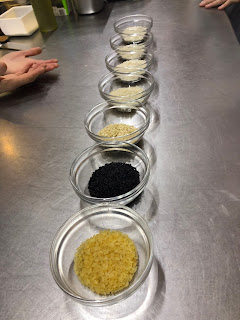Friuli Venezia Giulia
First, let's figure out where this region even is! I am not going to lie, before this lecture I had no idea that this was even a region here in Italy. This region is located in North East Italy, the furthest east region. It is also the fifth smallest region of Italy but is extremely important. During the Roman empire, this made the region very important because of the location in relation to the sea and the geographical closeness to other nations. Traces of the Romans are still visible in this region today, especially in the Roman-founded city of Aquileia, along the Natiso River. The area served as a strategic frontier fortress and was put in place to protect the Veneti. There are many fish scenery mosaics showing the importance of fishing in this area.
The name Friuli Venezia Giulia comes from the encompassing historical areas of Fruili and a small portion of Venezia Giulia. Until 2001, the name was written as Friuli-Venezia Giulia, until a modification in the Italian constitution was established, removing the hyphen.
This region's cuisine is highly influenced by the surrounding nations of Slovenia and Hungary, with some influence from its western border of Venice. Also, the economy of Friuli Venezia Giulia is something extremely important to the cuisine of this region. Within the cuisine, you can see the influence of the poor economy and usage of everything. Today, thanks to their famous wine, they have truly turned themselves around, becoming one of the most developed in Italy.
I found this point very interesting and wanted to share!
In this region, the fogolar was a small room in the center of the house around the fireplace. This functioned as a stove, aging center, and gathering place in each home. The fogolar was an important area in the home for cooking, aging salumi, working, praying, discussing, and even eating. Today, outside of Italy, a fogolar is actually a club. But in Italian (with dialect), fogolar means fireplace.
Fun Fact of the Day
List the Slow Food Procedure products and describe what they are.
Aglio di Resia: Garlic, grown in Resia
Cipolla di Cavasso e della Cal Cosa: a special type of onion
Cuc di mont: cow cheese
Formadi frant: Cheese made with the trimmings of other cheeses
Formaggio di latteria turnaria: cheese typical to the area, but the way of production is particular to this product
Pan di sorc: bread made with rye, wheat, and corn flour
Pestat di Fagagna: the pork fat is ground, mixed with carrots, onion, celery, sage, rosemary, leeks, garlic, and parsley; the salt, pepper, cinnamon, and pimento are added and then it is cased in a natural casing
Pitina: a type of sausage; it is sheep, goat, or roebuck meat grounded in a mortar with the addition of salt, black, pepper, and garlic; it is made into meatballs, dusted with corn flour and dried/smoked
Radic di mont: sort of like radicchio, but is wild; it is harvest in March
Today, I made a pastry for holidays and parties called gubana. It is a kind of bread dough rolled up with a lot of dried fruits, nuts, and spices. The dough was almost like a cinnamon roll dough, soft and full of butter. There is also an addition of honey, adding a depth of flavor that I thought was something different. The filling is made with raisins soaked in alcohol, pine nuts, walnuts, sugar, amaretto cookies, dry cookies (Mom! Like milk crackers), and lemon. It is then rolled and a specific shape is made. The flavor was a great depth that was very earthy. It would be something to make a plated dessert, with the flavors of the filling with a sponge cake. I enjoyed making this dish.

To wrap up, here are my tasting notes from the cuisine of Friuli Venezia Giulia:
- Sweet pasta! We had a dumpling today that was sweet and also a pasta with poppy seeds
- Apples are important
- Lots of potatoes are used
- The usage of herbs is A LOT
- Lots of nuts
- Onions
- A lot of hearty, earthy dishes
- Important spices: cinnamon and paprika
- Strong wine and vinegar for cooking
- Butter & Sugar! (Unlike the rest of Italy!)
- A lot of hearty soups, even some thickened with polenta
- Very rustic
With love,
Baylee
The name Friuli Venezia Giulia comes from the encompassing historical areas of Fruili and a small portion of Venezia Giulia. Until 2001, the name was written as Friuli-Venezia Giulia, until a modification in the Italian constitution was established, removing the hyphen.
This region's cuisine is highly influenced by the surrounding nations of Slovenia and Hungary, with some influence from its western border of Venice. Also, the economy of Friuli Venezia Giulia is something extremely important to the cuisine of this region. Within the cuisine, you can see the influence of the poor economy and usage of everything. Today, thanks to their famous wine, they have truly turned themselves around, becoming one of the most developed in Italy.
I found this point very interesting and wanted to share!
In this region, the fogolar was a small room in the center of the house around the fireplace. This functioned as a stove, aging center, and gathering place in each home. The fogolar was an important area in the home for cooking, aging salumi, working, praying, discussing, and even eating. Today, outside of Italy, a fogolar is actually a club. But in Italian (with dialect), fogolar means fireplace.
Fun Fact of the Day
List the Slow Food Procedure products and describe what they are.
Aglio di Resia: Garlic, grown in Resia
Cipolla di Cavasso e della Cal Cosa: a special type of onion
Cuc di mont: cow cheese
Formadi frant: Cheese made with the trimmings of other cheeses
Formaggio di latteria turnaria: cheese typical to the area, but the way of production is particular to this product
Pan di sorc: bread made with rye, wheat, and corn flour
Pestat di Fagagna: the pork fat is ground, mixed with carrots, onion, celery, sage, rosemary, leeks, garlic, and parsley; the salt, pepper, cinnamon, and pimento are added and then it is cased in a natural casing
Pitina: a type of sausage; it is sheep, goat, or roebuck meat grounded in a mortar with the addition of salt, black, pepper, and garlic; it is made into meatballs, dusted with corn flour and dried/smoked
Radic di mont: sort of like radicchio, but is wild; it is harvest in March
Today, I made a pastry for holidays and parties called gubana. It is a kind of bread dough rolled up with a lot of dried fruits, nuts, and spices. The dough was almost like a cinnamon roll dough, soft and full of butter. There is also an addition of honey, adding a depth of flavor that I thought was something different. The filling is made with raisins soaked in alcohol, pine nuts, walnuts, sugar, amaretto cookies, dry cookies (Mom! Like milk crackers), and lemon. It is then rolled and a specific shape is made. The flavor was a great depth that was very earthy. It would be something to make a plated dessert, with the flavors of the filling with a sponge cake. I enjoyed making this dish.

To wrap up, here are my tasting notes from the cuisine of Friuli Venezia Giulia:
- Sweet pasta! We had a dumpling today that was sweet and also a pasta with poppy seeds
- Apples are important
- Lots of potatoes are used
- The usage of herbs is A LOT
- Lots of nuts
- Onions
- A lot of hearty, earthy dishes
- Important spices: cinnamon and paprika
- Strong wine and vinegar for cooking
- Butter & Sugar! (Unlike the rest of Italy!)
- A lot of hearty soups, even some thickened with polenta
- Very rustic
With love,
Baylee




Comments
Post a Comment